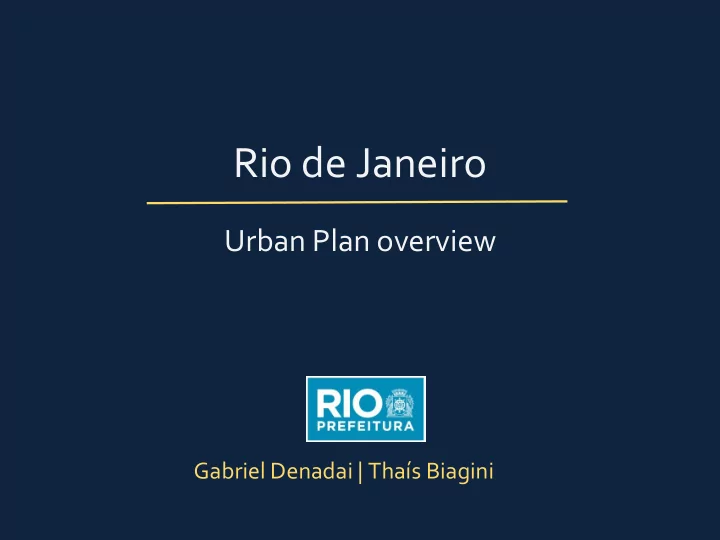

Rio de Janeiro Urban Plan overview Gabriel Denadai | Thaís Biagini
Agenda 1. Knowing City of Rio de Janeiro 2. Guaratiba Region overview 3. Guaratiba Sustainable District Masterplan Cabuçu-Piraquê River Park 4. Conclusions
Knowing Rio de Janeiro SOUTH KOREA National BRAZIL Government Regional Government METROPOLITAN AREA (21 cities/Pop. 12 mi.)
Knowing Rio de Janeiro SOUTH KOREA National BRAZIL Government Local Level
Rio de Janeiro City Hall Institutional organization Secretary of City Hall Structure Urbanism, Partnership with the ➔ Secretaries Infrastructure Departments of ➔ Public companies and Housing Transport, Heritage, Enviroment, and ➔ Foundations Urban planning others. ● City Master Plan (land use control) ● Urban projects (new streets, new parcel areas, sidewalk, public spaces) ● Local action plans ● Building permit Competences ➔ Planning and land (Constitution) use control
Knowing City of Rio Pop: 6.5 mi people | Density: 5265 hab/km² NORTH ZONE CENTER WEST ZONE SOUTH ZONE Airports Sugar Loaf Maracanã Stadium Copacabana beach Christ the redeemer
Knowing City of Rio World Heritage Site by UNESCO - Urban landscape
Agenda 1. Knowing City of Rio de Janeiro 2. Guaratiba Region overview 3. Guaratiba Sustainable District Masterplan Cabuçu-Piraquê River Park 4. Conclusions
Guaratiba 9
Guaratiba region in Rio de Janeiro Train connections Road connections Green Coast population area Guaratiba 2,9 % 13,5 % sustainable district
Environmental Protection 11
Environmental Protection 47% Protected lands 31% Low density occupation 22% Urban areas
Envioromental Protection Green Cabuçu-Piraquê Connection River Park Corridor Water Hillside Park Resources (Transition (Recovery and Zone) Protection) Sítio Roberto Sambaqui Burle Marx (Archaeological (Landscape Heritage) Heritage) 13
Local Economy Agriculture and Market EcoTourism Gastronomy Fishery 14
Local Economy Gastronomy Fishery Agriculture EcoTurism 15
Environment and Culture Roberto Burle Marx Place (World Heritage Candidate) 16
Challenges areas subject to flooding Environmental fragility need for preservation of the aquifer and vegetation Pressure of the urban new tunnel and BRT occupation system irregular occupation around environmental protection areas
Opportunities Urban voids areas for the river park and to build sustainable settlements Agriculture maintenance of the activity to contain the urban expansion and to supply Ecoturism expansion potential, boost in the local economy and environmental education Cycle modal integration of the cycleway system for daily commuting, leisure and tourism
Agenda 1. Knowing City of Rio de Janeiro 2. Guaratiba Region overview 3. Guaratiba Sustainable District Masterplan Cabuçu-Piraquê River Park 4. Conclusions
Cabuçu-Piraquê River Park Cabuçu-Piraquê River Park Private properties 20
River Park: some references Brooklands ( Milton Keynes – Reino Unido), Pacific Commons (Califórnia - EUA) e Fairway Chase (Queensland - Austrália)
Housing and Infrastructure: some references EcoDistricts | EcoNeighbourhoods Ref: Pedra Branca, Brasil. Ref: Pedra Branca, Brasil.
Mobility and Transport Cycle Plan Historical site Agriculture Cycle route Gastronomy EcoTourism
Agenda 1. Knowing City of Rio de Janeiro 2. Guaratiba Region overview 3. Guaratiba Sustainable District Masterplan Cabuçu-Piraquê River Park 4. Conclusions
Conclusions It is important not to lose sight of the diversity of regions that constitute a city, natural, urban voids and rural areas are a reality in Rio de Janeiro. This work was an important achievement in the sense of integration between disciplines and secretariats. The success of the implementation of the Masterplan and Park will be related to the support of the population and the rulers.
Sustainable cities, Healthy environment. 28
Thank you Rio de Janeiro | Brazil Gabriel Denadai | Thaís Biagini thais.smu@gmail.com gdenadai@gmail.com
Recommend
More recommend